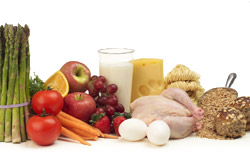This way of eating is devised to help cancer patients maintain or build up their weight. It means introducing foods high in energy and protein into the diet, with the emphasis on richness and increased calories. Many people with cancer experience eating problems at some point during the illness; however, everyone needs a certain level of energy to run their body, even if they are very inac¬tive. Once treatment regimes are completed, your relative can be encouraged to overcome any difficulties and resume normal eating habits. A diet that is advised for someone who is losing weight, or to help increase weight, is designed especially for that job; it is not recommended long term for people who are eating well.
To help your relative build up their strength, choose a selection of foods regularly from the following lists when preparing meals, according to dietary need.
– High energy foods: bread, pasta, cereals, cake, sweet bis¬cuits, and glucose sweets.
– High protein foods: meat, poultry, fish, beans, lentils, eggs, milk and cheese; however, to reduce the risk of infection, cook eggs well and avoid dairy products made from unpasteurised milk.
– Rich fatty foods: oils, butter, margarine, fatty meats and oily fish, full-fat dairy products (for example, fresh cream), nuts and mayonnaise. Look for labels that state whole milk and full-fat rather than products that claim to contain low-fat or ‘light’ ingredients.
– Vitamins and minerals: whilst vitamins and minerals are contained in most foods, some of the best sources are raw or lightly cooked fruit and vegetables with skins intact.
 If your relative is frail and has lost weight, you may need to use subtle ways to introduce extra goodness, without adding too much bulk.
If your relative is frail and has lost weight, you may need to use subtle ways to introduce extra goodness, without adding too much bulk.
– Add extra milk or cream to soups, puddings, custard, mashed potato, breakfast cereals and drinks in the form of fortified milk foods (available from pharmacies), evaporated or con¬densed milk or dried milk powder and use milk when the recipe states water.
– Add extra lentils, split peas, beans or egg noodles to meat stews and casseroles.
– Put a spoonful of real cream, rich ice-cream or condensed milk on to puddings.
– Use extra honey or syrup on breakfast cereals or porridge (made with milk or single cream).
– Keep a selection of nibbles, such as peanuts, crisps and dried fruits in handy dishes about the house.
– Spread butter, margarine and mayonnaise more thickly and add to mashed potato and vegetables.
